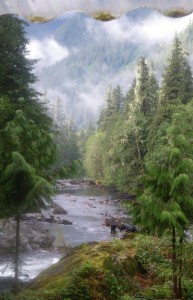
A view of the Kakweikan River from the front deck of Trapper’s cabin. Tranquil and relaxing not much else to say.
Our optional extra day is truly extra-ordinary, please take a look below.
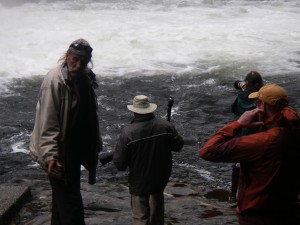
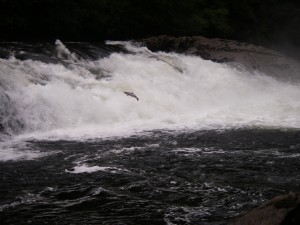
Trapper Rick is a fountain of knowledge about his unique river valley. He has worked for years to have the valley and bears protected and is very passionate about the area in which he lives. As shown in the first photo he is always willing to share his knowledge with the guest and has many stories about the bears he has known over the years. The guests photographing in the background are trying to get a photo like the second photo in the blog. A salmon jumping the falls. This will require you to click on the photo and then click again until it takes the full screen.
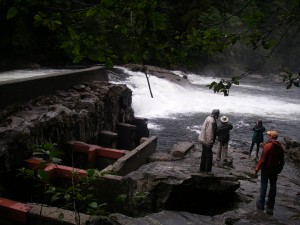
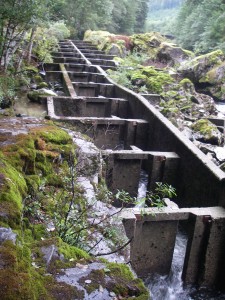
The small falls below Rick’s cabin for some reason created in the Department of Fisheries a need for a fish ladder. The fish had been making it over the falls since fish started going over falls too spawn so a ladder was not really needed but it did permit the weaker fish to make it further up the river and thereby weaken the genetic strain of these pink salmon. (Personal comment.) The orange support beams in the first photo go around the corner in the second photo to show the ladder by passing the falls. A trail from the cabin passes along the edge of the ladder. The third complete box up from the lower right corner is the one the grizzly bears climb into to grab salmon. It is like the fishponds at a kid’s school fair dip down and back up with a salmon in minutes. It is possible to be at the top of the trail and watch the bears disappear into the “salmon pen”.
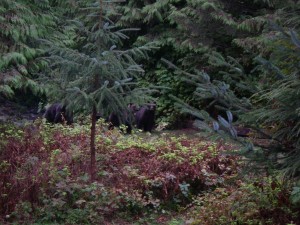
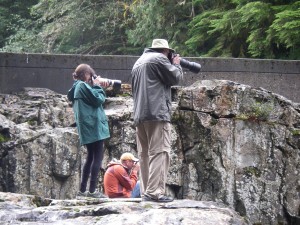
The bears in the first photo are the ones I mentioned in yesterday’s post. After we moved to the deck the mother grizzly and three two year old cubs came up the bank from the river to just below the deck of the cabin. This photo is one I took from my small camera before they came closer and it was necessary to be more concerned with the bears than getting better pictures. But I can assure you the guest obtained good photos. Once these bears moved down the river to the fishing area and we waited until they settled in to fish we then moved down the river nearer the fish ladder and more photos were taken. All in all an excellent day on the river.
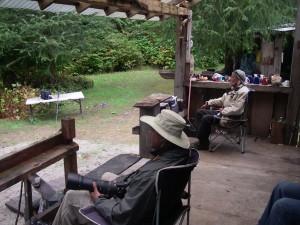
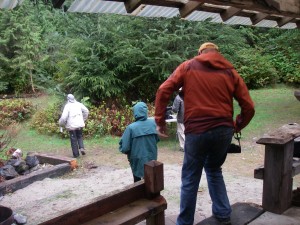
On completion of the short walk from the boat pool to the cabin the first order of business is to make sure there are no grizzly bears below the bank by the cabin and then we move to the deck. (I mention this important fact because on one of my visit I came within several meters (yards) of a bear). Just past the cabin there are falls on the river and a fish ladder were the grizzly bears come to fish. We normally sit on the cabin deck as it is possible to see the approaches to this fishing area and when bears appear we then leave the deck (picture 2) and follow Rick for a closer view and great pictures.
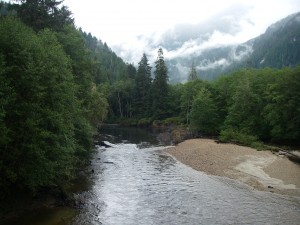
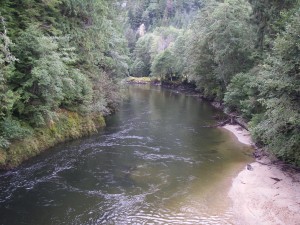
On the fifteen-minute walk to Rick’s cabin we spend some time on a decommissioned bridge (and that story you will have to hear from Rick) which provides views of the Kakweikan River. The first photo is looking up the river to the boat pool and the second down river to the bend where the cabin is located. Depending on the time of the year salmon will be spawning below the bridge while the bald eagles fly overhead.
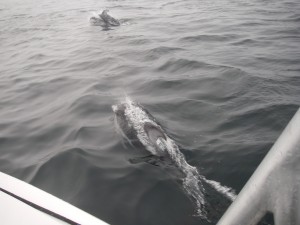
More photos of a wild river day go to “Categories” on the side and “River Day”. Also select “Google Map of Itinerary” under “Pages” to locate the icon for “Extra Day”.
On the extra day in camp we take a forty-five minute boat ride across Knight Inlet, through Thompson Sound to the Kakweikan River and spend a day with Trapper Rick. This river is located on the BC mainland and once there we travel by road to Rick’s cabin. Along the shores through Thompson Sound there are black bears and the occasionally grizzly bear but most of the grizzlies are viewed in the area of the cabin. On the boat ride we frequently come across large pods of pacific white-sided dolphins, which like to play in the bow wave and prop wash of the boat.
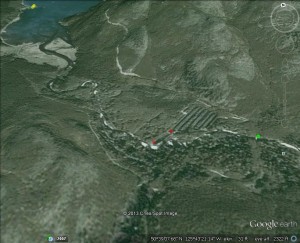
Once you have read the description below the map can be enlarged by clicking once on the photo and then once again and the photo should take the full screen.
The above photo is a selection taken from Google Earth that shows the Glendale River estuary in the upper left corner of the map. The river estuary is about 42 kilometers (26 miles) an hour and fifteen-minute boat ride from Grizzly Bear Lodge. Upon arriving at the river mouth the boat is tied to a float which is indicated by the yellow dots in the extreme upper left corner. Once at the float a flat bottom skiff is used to get to shore and the truck, which is used to drive to the spawning channel. The road runs along the estuary and the river past the base of the hills in the lower left section of the map and then curves to the green dot, which is a bridge over the Glendale River.
The zig zag line of trees are along the edge of the man made spawning channel. The road pass beside the top (right) edge of the last finger of the spawning area and then across and past the curves of the rest of the channels to the first red dot which is the first viewing stand. The second red dot is the stand normally used by Grizzly Bear Lodge. The area between the two red dots is a finger of land with the natural river on the right side and around the end of the finger to the holding pool on the left (top) side. The salmon holding pool is a result of an aluminum weir or small dam at the entrance to the spawning channel. This may be raised or lowered depending on how many salmon have entered the channel. The second stand is the preferred viewing area as there is an unobstructed view of the river and the holding pool and photos due not need to show the aluminum weir in the background.
If you go to “Pages” on the left and select “Gogle Map of Lodge Itinerary” and click the blue icon on the right it will be “Day 3” and be the location of the map shown above.
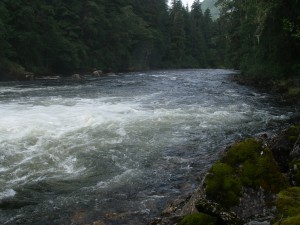
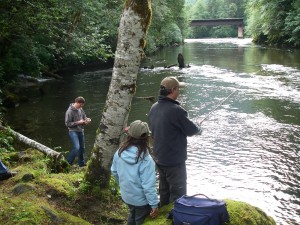 Two views of Trapper Rick’s Kakweikan River. The turbulent and fast water below the falls less than one hundred meters from Rick’s cabin and visible form the deck and the slow moving peaceful river adjacent to the cabin. Both parts of the river attract fishermen (sorry I just can’t be politically correct an use the term “fishers” as that refers to a weasel like animal and not someone enjoying themselves on a river bank) and women even though they may have never put a rod in the water before. From late July through September the river is full of pink salmon and coho and guests cannot resist just one cast and then “fish on” and they are hooked. It could be what is known as “fishing in a barrel” the only saving grace for the guides is that the river is “catch and release” so no fish come home to be cleaned.
Two views of Trapper Rick’s Kakweikan River. The turbulent and fast water below the falls less than one hundred meters from Rick’s cabin and visible form the deck and the slow moving peaceful river adjacent to the cabin. Both parts of the river attract fishermen (sorry I just can’t be politically correct an use the term “fishers” as that refers to a weasel like animal and not someone enjoying themselves on a river bank) and women even though they may have never put a rod in the water before. From late July through September the river is full of pink salmon and coho and guests cannot resist just one cast and then “fish on” and they are hooked. It could be what is known as “fishing in a barrel” the only saving grace for the guides is that the river is “catch and release” so no fish come home to be cleaned.

Just like that our season has come to an end. I would like to thank all of our wonderful guests and staff who made this year a huge success. I am happy to stay that all of our team is planning to return next season. We are actively taking bookings, with dates starting June 1 2025. Hope to see many of you next season.
The wildlife viewing this season was awesome. A couple highlights that come to mind was the shear number of salmon in our local rivers, as well as the abundance of Resident Orca. With salmon returns being so strong this year, we were happy to see bears in excellent condition. By the end of our season most of the bears had packed on a lot of weight and were getting very “picky” about what parts of the salmon they would eat. Hopefully this will translate into more cubs being born this winter. Another positive was the weather conditions. We had enough rain to keep our fire risks low and it made for some excellent wild berries. The bears took full advantage of this, with the berry season extending far past its normal conclusion. This did mean that we had to work hard to find bears during our summer season, (as they were often feeding on the berries deep into the forest), but moving forward it is excellent that they had such an abundant food supply. The Humpbacks also didn’t disappoint, with great numbers and a few new calves returning with their mothers to feed. After a slower year for resident Orca sightings, this season was one of the best that I can remember. In fact as Im writing this the A62 and A23’s are still being spotted in the area by dedicated biologists. Strong numbers of Chinook and Chum salmon are providing them with a steady food source. There are a lot of positive signs and we are hopeful that 2025 will be another great season.
Over the winter and spring we will be doing some repairs and maintenance. We plan on having a new cedar front deck built in time for the 2025 season, as well as new ceilings and paint in parts of the lodge and rooms. Theres always projects on the go.
Felix, Julien, Ryan, Zack and Myself all look forward to welcoming guest in June. See everyone soon.
Angus Reid
Visit our Blog